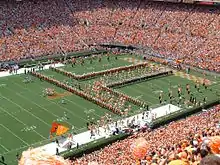Morristown, Tennessee
Morristown is a city in and the county seat of Hamblen County, Tennessee, United States.[12] Morristown also extends into Jefferson County on the west and southern ends. The population was 29,137 at the 2010 United States Census,[13] and was estimated to be 30,193 in 2019.[7] In 2019, the city was reported to have a daytime population of 118,600.[14]
Morristown, Tennessee | |
|---|---|
| City of Morristown | |
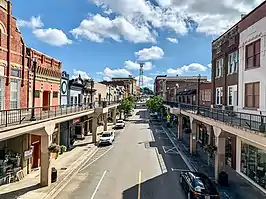 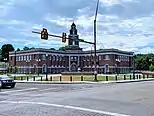  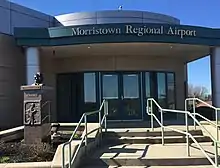 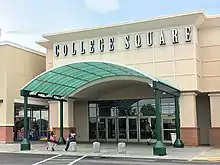 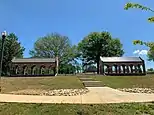 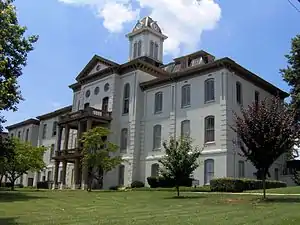 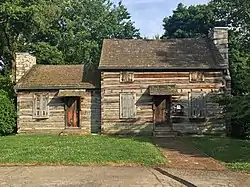 Images, from top down, left to right: Main Street Historic District in downtown Morristown, Morristown City Center, Rose Center, main terminal of Morristown Regional Airport, College Square Mall, Fulton-Hill Park on the historic Morristown College site, Hamblen County Courthouse, Crockett Tavern Museum | |
 Seal  Logo | |
| Nickname(s): | |
| Motto(s): "A City Always Expanding" | |
 Location in Hamblen County and the state of Tennessee | |
| Coordinates: 36°12′38″N 83°17′46″W | |
| Country | United States |
| State | Tennessee |
| Counties | Hamblen, Jefferson |
| Settled | ca. 1787 |
| Incorporated | 1855[3] |
| Founded by | Gideon Morris |
| Named for | Gideon Morris |
| Government | |
| • Type | Mayor-council |
| • Mayor | Gary Chesney |
| • Vice Mayor | Kay Senter |
| • City Council | Council members
|
| Area | |
| • Metropolitan city | 27.64 sq mi (71.59 km2) |
| • Land | 27.60 sq mi (71.48 km2) |
| • Water | 0.04 sq mi (0.11 km2) |
| Elevation | 1,350 ft (397 m) |
| Population (2010) | |
| • Metropolitan city | 29,137 |
| • Estimate (2019)[7] | 30,193 |
| • Density | 1,094.07/sq mi (422.42/km2) |
| • Urban | 65,631[8] |
| • Metro | 142,749[9] |
| Demonym(s) | Morristownian |
| Time zone | UTC-5 (EST) |
| • Summer (DST) | UTC-4 (EDT) |
| ZIP codes | 37813-37816 |
| Area code(s) | 423 |
| FIPS code | 47-50280[10] |
| GNIS feature ID | 2404307[11] |
| Primary Airport | Morristown Regional Airport |
| Interstate | |
| U.S. Route | |
| Website | www |
It is the principal city of the Morristown Metropolitan Statistical Area, which encompasses all of Grainger, Hamblen, and Jefferson counties.[15] The Morristown metropolitan area is also part of the Knoxville-Morristown-Sevierville Combined Statistical Area.[15]
History
Early years and settlement
The first European settler was Gideon Morris, a farmer who arrived from the Watauga Settlement, a settlement that was leased to settlers from the inhabiting Cherokee tribes.[16] Morris, along with his siblings, petitioned to have the Watauga Settlement annexed in the State of North Carolina.[16] After the success of the petition, the settlement was named Morristown, and land grants containing Hamblen and Jefferson counties were assigned to Morris and his brothers Daniel and Absalom in 1787 by North Carolina officials.[17][18]
Pioneer and folk-hero David Crockett lived in present-day Morristown with his father, John Crockett, and established a tavern in 1794. The current-day Crockett Tavern Museum sits at the approximate location of the former tavern, and is listed on the National Register of Historic Places.[19]
Incorporation and establishment as Hamblen's seat
In 1855, Morristown was incorporated into a city.[20] During the period between 1855 and 1870, Morristown's limits were divided along Main Street into Grainger and Jefferson counties.[20] Many residents brought concerns regarding transportation and communication access in Morristown, and neighboring communities such as Russellville and Panther Springs.[21] After working with officials from the neighboring counties and the state government, Hamblen County was formed from portions of Grainger, Jefferson, Hawkins, and Greene counties.[21]
Morristown was chosen as the county seat of Hamblen County shortly after its formation in 1870.[20]
Civil War
As the Civil War approached, the town's sympathies were divided between the Union and secessionist sides. In December 1863, some 25,000 Confederate Army soldiers under the command of General James Longstreet arrived at Bethesda Presbyterian Church, northeast of the town, to spend the winter, after the Battle of Bean's Station. They remained there until February 1864 and used the Bethesda Church building as a hospital.[22][23] Military engagements occurred near the church in both October and November 1864.[22] On October 28, 1864, Union General Alvan C. Gillem attacked Confederate forces under General John C. Vaughn in the Battle of Morristown. They fought in and around the town with Gillem routing Vaughn's Confederates in what became known as "Vaughn's Stampede." Vaughn was forced to retreat to Carter's Station on the Watauga River in northeastern Tennessee. The battle resulted in about 335 total casualties.[24][25][26] In the Battle of Bull's Gap ("Gillem's Stampede") in November, Confederate forces under General John C. Breckinridge prevailed over Gillem's troops, chasing the Union forces westward to a defensive position at Strawberry Plains near Knoxville.[26][27] During one of these skirmishes, a cannonball penetrated one of the church walls, causing structural damage that was repaired by reinforcing the walls with large iron rods.[22] The Union Army used the church as a hospital for soldiers wounded in these operations.[27] Many soldiers from both sides are interred in the Bethesda Church cemetery. Eighty of the wartime burials are unidentified.[22][23]
Industrial Revolution
Morristown saw a steady shift into a industrially-based economy in the early beginnings of the Industrial Revolution around the early to late 19th century. The first industry in the area was the Shields Paper Mill, located on the Holston River, operating from 1825 to 1861.[28] Other prominent early businesses included the Morristown Manufacturing Company, and the later Knoxville based J. F. Goodson Coffee Company in 1882.[28][29]
Peavine Railroad
From 1891 to 1928, Morristown was a terminal on the Knoxville and Bristol Railroad, commonly known by locals as the "Peavine Railroad." The railroad was a branch line of the Southern Railway that ran from downtown Morristown on Main Street to Corryton, a bedroom community outside of Knoxville.[30][31] The Peavine Railroad had first operated between Morristown and Bean Station, with plans to connect north to the Cumberland Gap, but instead extended west through Grainger County towards Knoxville.[32]
American Enka and the labor movement
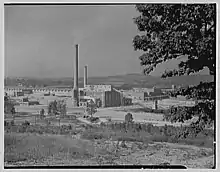
In 1944, the American Enka Company, a rayon fiber producer based out of Asheville, North Carolina, began construction on a 230-acre plant in the Lowland region of Morristown, beginning operations in 1947.[33][34]
In March 1950, workers at the facility walked out on strike. Officials from American Enka Company then advertised for replacements of the striking workers. Tensions soon built when residents of Morristown and Lowland appeared at the gates of the Enka plant to apply for the listed jobs. Violence then followed, with shots fired, cars damaged, and one adjacent house destroyed by dynomite. Then Governor of Tennessee, Gordon Browning, dispatched National Guard troops to restore order at the Enka factory. By the end of the strike and following acts of violence and vandalism, its story had become national front-page news and on-site congressional hearings regarding labor relations and the labor movement were held in Morristown, led by Democratic Senator Hubert Humphrey.[35][36]
In 1985, the American Enka facility was acquired by BASF, and continued under their operations until 1992, when it was sold to Lenzing AG.[33] The plant closed in 2005, after the company that operated the plant, Liberty Fibers, filed for bankruptcy.[37] The plant site and its adjacent wastewater treatment plant have since been annexed into the Morristown city limits.[37]
Industrial development
Beginning in 1959 following then presidential candidate John F. Kennedy's exposure to poverty in Appalachia, Morristown officials began a joint effort with Tennessee economic development representatives to establish the city as a major industrial hub, and the program began with the construction and completion of the East Tennessee Valley Industrial District (ETVID) industrial park in eastern Morristown near Russellville.[38]
By 1978, the 375 acres (1.52 km2) ETVID industrial park had reached its estimated capacity, prompting city officials to develop a second industrial park.[38] After acquiring a 670 acres (2.7 km2) site in western Morristown near Morristown Regional Airport in the same year, the site was developed into the Morristown Airport Industrial District (MAID) industrial park in 1981.[38] Five months after the park's completion, two companies opened facilities at the MAID.[38] As overall economic prosperity continued to make gains in Morristown, city officials and development representatives have cited Morristown's industrial development initiative as an example of economic growth:[38]
In the 1990s, the City of Morristown acquired over 900 acres (3.6 km2) near Interstate 81 exit 8 for its third industrial park, the East Tennessee Progress Center (ETPC).[39] Initial site development such as roadway and utility upgrades were completed in 2001.[39] Several large manufacturers opened facilities at the site, but further infrastructure upgrades, grading work, and property acquisition was done on the site through out the 2000s and 2010s.[39][40]
Following the 2007-2012 global economic crisis, Morristown saw the loss of one of its largest employers, Berkline, which closed after filing for Chapter 11 bankruptcy in 2011.[41] The furniture manufacturer, which relocated to the city in 1937, eliminated 602 jobs, and ended an era of Morristown being known as a predominately furniture manufacturing hub:[42]
"For two or three generations, Morristown has been considered a furniture town, and this is the last of the major furniture operations here."
— Hamblen County Mayor Bill Brittain, "Furniture maker Berkline closing Morristown operation", Knoxville News Sentinel (2011)
In 2018, Belgian bus manufacturer Van Hool announced the construction of a 500,000 square feet (46,000 m2) facility at the ETPC,[39] one of the largest industrial development projects in the history of Morristown.[43][44] The project expects to create an estimated 650 jobs, over $47 million dollars in private investment and an influx of interest of further industrial development in the Morristown area.[39][45]
Downtown emergence and the "Skymart" project
The road now known as Main Street was first reported to have been built in 1792-1793 in an area between Grainger and Jefferson counties.[46]
By 1833, Morristown had its first post office and store located along Main Street.[46] Fourteen years later, railroad lines were built, stimulating further commercial growth until the beginning of the American Civil War.[46] Morristown's Main Street district, measuring approximately 1 square mile (2.6 km2), arose from the intersection of two railroad lines, gradually turning Morristown into wholesale/retail hub after the end of the Civil War.[46]
By the dawn of the 20th century, Morristown saw another era of growth. Several new buildings emerged in the downtown area, including the Henry Street Post Office, the First National Bank Building, currently the second tallest building in downtown Morristown, and the Princess Theater. The Princess Theater would be the first theater in Morristown, and showcased touring musical acts, ministerial shows, pageants, films, and special Grand Ole Opry performances. Following the opening of theaters in neighboring shopping complexes, the Princess Theater would close in 1982, and demolished in 1995.[46]
Following the 1950s, the downtown district saw losses in revenue as a suburban shopping mall on the city's west side jeopardized businesses downtown, and the city developed a plan to modernize Main Street by creating an "overhead sidewalk" as part of the nationwide push for urban renewal projects, enabling businesses to form on the second floor of existing buildings while serving as a canopy for passage below. Building owners spent nearly $2 million ($16 million today) upgrading their properties and linking them to ramps, while the government contributed over $5 million to build the elevated walkways.[46] The underground channel for Turkey Creek was also enlarged and rerouted. In 1962, Turkey Creek, which bisects the street, flooded and damaged the downtown commercial district. The project was completed in 1967, becoming the first second-story sidewalk system in an American city.[47] Over time, the Skymart has served as little more than a remnant of the idealism of 1960s urban renewal projects. Despite the aftermath of the project, the overhead sidewalks still stand in the downtown area.[48][49]
Morristown is embarking on a resurrection of the Skymart, eyeing the structure as a key redevelopment tool of turning downtown into a social and commercial hub. It has been made a key element in a greenway master plan along Turkey Creek, with plans to connect downtown Morristown to Cherokee Park and Cherokee Lake.[50][51] In an effort to renew public interest, city officials, the Crossroads Downtown Partnership, and the Morristown Area Chamber of Commerce hold events in the city's downtown or the "Skymart District" throughout the year, mainly during the warmer months of May to September.[52]
On March 22, 2016, Main Street along with the rest Morristown's downtown district was officially listed on the National Register of Historic Places.[53]
Geography
Morristown is situated in the upper region of East Tennessee in the Tennessee Valley between the Great Smoky Mountains to the south, and Clinch Mountain to the north.[17] It is considered part of a region known as the 'Lakeway Area,' consisting of an land area surrounding Cherokee and Douglas lakes.[17] It is positioned nearly at a midpoint between Knoxville and the Tri-Cities region.[54]
According to the 2010 census, the city has a total area of 28.0 square miles (72.4 km2), of which 0.04 square miles (0.1 km2), or 0.19%, are water. Cherokee Lake, an artificial reservoir built by the Tennessee Valley Authority in the 1940s, is north of the city.
Neighborhoods
Important suburbs
Climate
Morristown falls in the humid subtropical climate zone (Köppen climate classification Cfa), although it is not quite as hot as areas to the south and west of Tennessee due to the higher elevations. Summers are hot and humid, with July highs averaging 85 °F (29 °C), lows averaging 66 °F (19 °C), and an average of eight days per year with temperatures above 90 °F (32 °C).[55] Winters are generally cool, with occasional small amounts of snow. January averages a high of around 45 °F (7 °C) and a low of around 28 °F (−2 °C), although low temperatures in the single digits and teens are not uncommon. The record high for Morristown, since 1994, is 103 °F (39 °C), while the record low is −2 °F (−19 °C). Annual precipitation averages around 44.3 in (1,125 mm), and average winter snowfall is 11.7 inches (30 cm). The average monthly relative humidity is around 70 percent.
| Climate data for Morristown, TN (since 1987) | |||||||||||||
|---|---|---|---|---|---|---|---|---|---|---|---|---|---|
| Month | Jan | Feb | Mar | Apr | May | Jun | Jul | Aug | Sep | Oct | Nov | Dec | Year |
| Record high °F (°C) | 77 (25) |
75 (24) |
86 (30) |
92 (33) |
93 (34) |
102 (39) |
103 (39) |
102 (39) |
103 (39) |
91 (33) |
84 (29) |
77 (25) |
103 (39) |
| Average high °F (°C) | 45 (7) |
50 (10) |
60 (16) |
68 (20) |
75 (24) |
82 (28) |
85 (29) |
85 (29) |
79 (26) |
69 (21) |
58 (14) |
48 (9) |
67 (19) |
| Daily mean °F (°C) | 37 (3) |
41 (5) |
49 (9) |
57 (14) |
65 (18) |
73 (23) |
76 (24) |
75 (24) |
69 (21) |
59 (15) |
48 (9) |
39 (4) |
57 (14) |
| Average low °F (°C) | 28 (−2) |
32 (0) |
38 (3) |
47 (8) |
54 (12) |
63 (17) |
66 (19) |
66 (19) |
59 (15) |
49 (9) |
39 (4) |
31 (−1) |
48 (9) |
| Record low °F (°C) | 1 (−17) |
−2 (−19) |
6 (−14) |
26 (−3) |
36 (2) |
43 (6) |
51 (11) |
49 (9) |
37 (3) |
25 (−4) |
5 (−15) |
4 (−16) |
−2 (−19) |
| Average precipitation inches (mm) | 4.2 (110) |
3.9 (99) |
4 (100) |
4 (100) |
4.2 (110) |
3.7 (94) |
5 (130) |
3.5 (89) |
3.1 (79) |
2.2 (56) |
3.5 (89) |
4 (100) |
44.3 (1,130) |
| Average snowfall inches (cm) | 3.9 (9.9) |
3.6 (9.1) |
1.5 (3.8) |
0.1 (0.25) |
0 (0) |
0 (0) |
0 (0) |
0 (0) |
0 (0) |
0 (0) |
0.2 (0.51) |
2.4 (6.1) |
11.7 (30) |
| Average relative humidity (%) | 73 | 69 | 65 | 62 | 67 | 70 | 72 | 72 | 69 | 70 | 69 | 72 | 69 |
| Source: Weatherbase.com[55] | |||||||||||||
Demographics
| Historical population | |||
|---|---|---|---|
| Census | Pop. | %± | |
| 1870 | 950 | — | |
| 1880 | 1,350 | 42.1% | |
| 1890 | 1,999 | 48.1% | |
| 1900 | 2,973 | 48.7% | |
| 1910 | 4,007 | 34.8% | |
| 1920 | 5,875 | 46.6% | |
| 1930 | 7,305 | 24.3% | |
| 1940 | 8,050 | 10.2% | |
| 1950 | 13,019 | 61.7% | |
| 1960 | 21,267 | 63.4% | |
| 1970 | 20,318 | −4.5% | |
| 1980 | 19,570 | −3.7% | |
| 1990 | 21,385 | 9.3% | |
| 2000 | 24,965 | 16.7% | |
| 2010 | 29,137 | 16.7% | |
| 2019 (est.) | 30,193 | [7] | 3.6% |
| Sources:[56][57][58] | |||
As of the census of 2010,[10] there were 29,137 people, 11,412 households, and 7,278 families residing in the city. The population density was 1,194.7 people per square mile (461.2/km2). There were 12,705 housing units at an average density of 528.1 per square mile (203.9/km2). The racial makeup of the city was 86.52% White, 6.63% African American, 0.87% Asian, 0.20% Pacific Islander, and 2.15% from two or more races. Those of Hispanic or Latino origins were 19.37% of the population.
There were 11,412 households, out of which 22.5% had children under 17 years of age living with them, 45.2% were married couples living together, 11.4% had a female householder with no husband present, and 36.2% were non-families. 31% of all households were made up of individuals, and 11.0% had someone living alone who was 65 years of age or older. The average household size was 2.47 and the average family size was 3.07.
In the city, the population was spread out, with 24.85% under 17 years of age, 9.45% from 18 to 24, 26.5% from 25 to 44, 23.2% from 45 to 64, and 16% who were 65 years of age or older. The median age was 36 years. For every 100 females, there were 91.2 males. For every 100 females age 18 and over, there were 91.9 males.
The median income for a household in the city was $27,005, and the median income for a family was $33,391. Males had a median income of $26,724 versus $20,515 for females. The per capita income for the city was $15,894. About 14.6% of families and 19.2% of the population were below the poverty line, including 24.9% of those under age 18 and 17.3% of those age 65 or over.
Economy
Being centrally located in the East Tennessee region, Morristown serves at the hub for a labor market area pulling most of its labor force from a surrounding seven-county area of 337,000 people.[59] Morristown and its metropolitan area in 2019, was reported to have a gross metropolitan product of US$5.1 billion dollars.[14]
Top employers
According to the Morristown Urbanized Area's Lakeway Region 2040 Long Range Transportation Plan published in 2017,[60] the top employers in the city are:
| # | Employer | # of Employees |
|---|---|---|
| 1 | MAHLE Powertrain | 1,029 |
| 2 | Koch Foods | 997 |
| 3 | JTEKT | 864 |
| 4 | Walmart | 757 |
| 5 | Walters State Community College | 743 |
| 6 | Morristown-Hamblen Healthcare Systems | 716 |
| 7 | Howmet Aerospace | 526 |
| 8 | Team Technologies | 513 |
| 9 | Lear Corporation | 455 |
| 10 | Rich Products | 438 |
| 11 | HealthStar Physicians | 373 |
| 12 | City of Morristown | 338 |
Real estate
As of August 2020, Morristown has seen a high demand for both single-family and multi-family residential developments.[61][62]
A study by Middle Tennessee State University found that the Morristown metropolitan area saw a 8.1% increase in housing prices in the third quarter of 2019 compared to the same period in 2018.[63]
As of 2010, the median price for a home in the Morristown-Hamblen area was $125,600, compared with $142,000 in the Knoxville metropolitan area, and $177,900 nationally.[18]
In 2010, the Morristown-Hamblen area was home to over 1,000 businesses, employing over 25,000 people.[18] Total property tax revenue was almost equally divided amongst residential, commercial, and industrial properties, with residential property tax supplying 50.1%, commercial at 26.1%, and industrial at 20.1%.[18]
Manufacturing
Morristown is considered to be one of the largest manufacturing and industrial hubs in the state of Tennessee.[64] There are several industrial parks located in the eastern, western and southern parts of the city,[40] and over 100 manufacturers have based their facilities in Morristown, ranging from food processing, aerospace technology, machine and parts production, plastics engineering, and many other industries.[65][66]
In 2019, the Morristown area was reported to be home to 109 manufacturing companies, with projections showing Morristown could gain 3,000 jobs and over $600,000,000 dollars in investment in the manufacturing sector alone by the year 2024.[62]
Morristown's manufacturing market employs nearly 10,000 or 24% of the workforce in Hamblen County, and an extra 11,000 commuting from surrounding counties such as Jefferson, Grainger, Cocke, and Hawkins for employment.[59]
Retail
Morristown is considered a hub for retail, with the indoor regional College Square Mall serving an area of 300,000 people, and a diverse array of locally owned shops and franchised stores in retail developments dispersed around Morristown and in its downtown area.[54][67] In 2016, the city saw nearly $1.4 billion in retail sales.[20]
Arts and culture
Festivals
There are several annual festivals and events held in Morristown,[68] some of the more notable events include:
- Morristown Strawberry Festival - festival held every May celebrating strawberries harvested in Morristown.[69]
- Morristown Craft Beer Festival - Craft beer festival with live music held at the Morristown Farmers Market every September.[70]
- Mountain Makins Festival - Arts and crafts festival held at the Rose Center every October.[71]
Historic sites
- Bethesda Presbyterian Church
- Crockett Tavern Museum
- General Longstreet's Headquarters Museum[72]
- Morristown Main Street Historic District[73]
- Morristown Cemetery
- The site of Morristown College, now Fulton-Hill Park
- Rose Center
Sports
Minor league baseball
Morristown hosted several Minor League Baseball teams from 1910 to 1961 at Sherwood Park.[74] The Morristown Jobbers became charter members of the Southeastern League in 1910.[75] The Jobbers continued in the Appalachian League in 1911 and played each season through 1914.[76] From 1923 to 1925, the city's entry in the league was called the Morristown Roosters.[75] In 1948, the Morristown Red Sox became charter members of the Mountain States League in which they played through 1954.[75] The team won the league championship in their first season.[77] The Red Sox folded early in the 1954 season and were replaced in the league by the Morristown Reds.[78][79] The Morristown Cubs, the city's final professional baseball team played in the Appalachian League from 1959 to 1961 and won the 1959 pennant.[75][80]
Walters State baseball
Walters State Community College's Senators baseball team has qualified in 8 JUCO world series tournaments and won 1 JUCO WORLD SERIES.
Little League
- In 1985 and 1987, Morristown had teams qualify for the Little League World Series; the 1985 team finished third. The Morristown teams are two of eight Tennessee teams that have advanced to the series in Williamsport, Pennsylvania.
- In 2006, Morristown placed fourth in the Little League Softball World Series.[81]
- In 2007, Morristown won the Little League Softball World Series.[82]
Parks and recreation
- Parks and public recreation areas
- Panther Creek State Park
- Cherokee Park
- Public access to Cherokee Lake via swimming areas and boat launches
- Morristown City Parks and Recreation (15 locations including Civic, Frank Lorino, Fred Miller, and Fulton-Hill parks)[83]
- Disc Golf Courses
- Cherokee Park Disc
- Morristown Rotary Disc Course
- Kiwanis Disc Course
- Panther Creek State Park Disc Course
- Golf
- Morristown Golf and Country Club
- The Country Club
Government
Morristown uses the mayor-council government system, which was established in 1855 when the city was incorporated. Morristown is governed by a seven-member city council composed of the mayor and six council members, four members are elected from single-member districts and two members are elected at-large for the entire city.[5] The citizens elect the mayor to a four-year term and the six council members to two-year terms.
The City Council meets every first and third Tuesday of each month at 5:00 p.m. in the Council Chambers at the City Center building.[5]
Morristown is represented in the Tennessee House of Representatives in the 10th district by Representative Rick Eldridge, a Republican.[84]
In the Tennessee State Senate, Morristown is represented by the 1st district by Senator Steve Southerland, also a Republican.[85]
Morristown is represented in the United States House of Representatives by Republican Diana Harshbarger of the 1st congressional district.[86]
Education
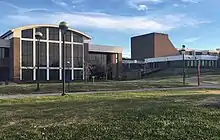
Public schools
Public schools in Morristown are operated by the Hamblen County Department of Education. There are four middle schools: East Ridge, Lincoln, Meadowview, and Westview. Morristown has two high schools: Morristown-Hamblen High School East and Morristown-Hamblen High School West.[87]
Colleges
The main campus of Walters State Community College is located in Morristown.[88]
The main campus and the aviation technology expansion campus of the Tennessee College of Applied Technology - Morristown, are located in Morristown.
Satellite campuses of King University and Tusculum College are located in Morristown.
Media
Newspaper
- Citizen Tribune
In film
- The 1981 horror film The Evil Dead, had been filmed in neighboring Bean Station and in Morristown near Kidwell's Ridge Road. The cabin featured significantly in the film had burned down, with the only remains being bricks from the cabin's chimney.[89]
- The 2005 film Five Across the Eyes was filmed in Morristown.
Infrastructure
Healthcare
Morristown is home to the Morristown-Hamblen Hospital. The hospital has a 167 room capacity with 23 designated for emergency use. It is considered the main healthcare center in the Morristown metropolitan area.[90]
Utilities
Morristown Utilities System (MUS) provides electricity, water, sewer, and fiber broadband internet to the City of Morristown and several eastern Hamblen County residents and businesses. It provides services to approximately 15,000 customers.[91]
Appalachian Electric Cooperative (AEC), a utilities company based out of New Market in neighboring Jefferson County, provides electricity and fiber broadband internet for western and northern portions of Morristown, portions of Hamblen County, Jefferson County (including New Market, Baneberry, Jefferson City, Dandridge, and White Pine), and Grainger County (including Bean Station and Rutledge).[92][93] AEC, as of June 2018, provides services to 46,000 customers.[93]
Transportation
All U.S. routes, state routes in Morristown, along with I-81, are maintained by the Tennessee Department of Transportation (TDOT) in TDOT Region 1, which consists of 24 counties in East Tennessee.[95] Streets, sidewalks, and greenways in the Morristown-Hamblen area are maintained by either the Hamblen County Highway Department or the City of Morristown Public Works Department.[96][97][98][99]
In 2002, the United States Census Bureau declared the municipalities of Morristown, Jefferson City, White Pine, and portions of unincorporated Hamblen and Jefferson counties as a part of an urbanized area.[100] The Lakeway Area Metropolitan Transportation Planning Organization (LAMPTO) was created following the requirement of a designated MTPO for all urbanized areas in the United States.[100] The LAMPTO plans and coordinates regional transportation projects in Morristown and its urbanized area.[100]
Principal highways
 I-81
I-81 US 11E (Morris Boulevard, West Andrew Johnson Highway)
US 11E (Morris Boulevard, West Andrew Johnson Highway) US 25E (Davy Crockett Parkway)
US 25E (Davy Crockett Parkway) SR 32 (concurrent to US 25E)
SR 32 (concurrent to US 25E) SR 34 (concurrent to US 11E)
SR 34 (concurrent to US 11E) SR 66 (Doctor Martin Luther King Jr. Parkway, East Andrew Johnson Highway, First North Street)
SR 66 (Doctor Martin Luther King Jr. Parkway, East Andrew Johnson Highway, First North Street) SR 160 (Governor Dewitt Clinton Senter Parkway, Air Park Boulevard, Enka Highway)
SR 160 (Governor Dewitt Clinton Senter Parkway, Air Park Boulevard, Enka Highway)
Major surface routes
 SR 113
SR 113 SR 341 (Alpha Valley Home Road)
SR 341 (Alpha Valley Home Road) SR 342 (Panther Creek Road)
SR 342 (Panther Creek Road) SR 343 (Cumberland Street, Buffalo Trail)
SR 343 (Cumberland Street, Buffalo Trail) SR 344 (Old Russellville Pike)
SR 344 (Old Russellville Pike) SR 474 (Merchants Greene Boulevard)
SR 474 (Merchants Greene Boulevard)- Brights Pike
- Cherokee Drive
- Commerce Boulevard
- Drinnon Drive
- Economy Road
- Kidwell Ridge Road
- Liberty Hill Road
- Lincoln Drive
- Sulpher Springs Road
- Veterans Parkway
- Walters Drive
Rail access
Norfolk Southern Railway operates freight transport through out Morristown along several lines, including the Crescent Corridor.[101][102]
Mass transit
Public transportation is provided by Lakeway Transit. Three fixed bus routes connect to the downtown area, most residential areas, and major shopping centers throughout the city. Lakeway Transit operates using passenger fares, and city, state, federal funding.[103]
Airport
Morristown and the surrounding area is served by Morristown Regional Airport (IATA:MOR), a 160-acre (65 ha) airport equipped with one 5,717-foot (1,743 m) runway. The airport is located southwest of Morristown's central business district near the neighborhood of Alpha, and is operated by the municipal government.[104]
Notable people
- Ermal Allen, professional football player and coach[105]
- Darrius Blevins, professional football player[106]
- James E. Bruce, Kentucky state representative[107]
- Arnold W. Bunch Jr., U.S. Air Force four-star general and current commander of Air Force Materiel Command[108]
- Davy Crockett, pioneer; grew up in Morristown, born in nearby Greene County[109]
- Harrison Ford, actor, pilot, environmental activist[110]
- Mike Ford, former NASCAR crew chief for Denny Hamlin[111]
- Elaine Hendrix, animal rights activist and actress[112]
- Tim Horner, professional wrestler, politician[113]
- Evelyn Bryan Johnson, aviator, Morristown Regional Airport manager[114]
- Josiah Leming, contestant in the seventh season of American Idol who was eliminated in the top 50 but subsequently signed a recording contract with Warner Bros. Records[115]
- Brett Martin, professional baseball player[116]
- William McFarland, U.S. congressman from 1875 to 1877 and Morristown mayor from 1882 to 1885
- Rickey Parkey, champion boxer
- Gideon Morris, trans-Appalachian pioneer and founder of Morristown[117]
- Frankie Randall, world champion boxer[118]
- Randy Sanders, former quarterback for Morristown East High School and the Tennessee Volunteers; currently head football coach for the East Tennessee State Buccaneers
- Dewitt Clinton Senter, Governor of Tennessee, legislator[119]
- Joe Shipley, former professional baseball player and head coach of the East Tennessee State University baseball team[120]
- James Stewart, professional football player[121]
- Uncle Am Stuart, early country music fiddle player
- Jane Wagner, playwright and actress[122]
- Herbert S. Walters, Democratic United States Senator, namesake of Walters State Community College[123]
- Calvin Ward, soldier, Medal of Honor recipient[124]
- John A. Willis, Theatre World and film book editor, theatre awards producer, actor, and educator.[125]
References
- "Mo'Town Madness". Manley Baptist Church. Retrieved July 27, 2020.
- "Disc Golf". Visit Morristown, Tennessee. City of Morristown. Retrieved September 3, 2020.
- Morristown website Archived 2013-01-01 at the Wayback Machine. Retrieved January 16, 2013.
- "Morristown". Municipal Technical Advisory Service. Retrieved August 9, 2020.
- City of Morristown. "Council". mymorristown.com. Retrieved June 9, 2020.
- "2019 U.S. Gazetteer Files". United States Census Bureau. Retrieved July 30, 2020.
- "Population and Housing Unit Estimates". United States Census Bureau. May 24, 2020. Retrieved May 27, 2020.
- "Morristown, TN Urbanized Area". Census Reporter. Retrieved September 17, 2020.
- "Metropolitan and Micropolitan Statistical Areas Population Totals and Components of Change: 2010-2019". United States Census Bureau. Retrieved July 14, 2020.
- "U.S. Census website". United States Census Bureau. Retrieved 2008-01-31.
- "US Board on Geographic Names". United States Geological Survey. 2007-10-25. Retrieved 2008-01-31.
- "Find a County". National Association of Counties. Retrieved 2011-06-07.
- "Geographic Identifiers: 2010 Census Summary File 1 (G001): Morristown city, Tennessee". American Factfinder. U.S. Census Bureau. Archived from the original on February 13, 2020. Retrieved January 26, 2018.
- "Morristown, TN". Best Small Places for Business and Careers 2019. Forbes. October 2019. Retrieved October 22, 2020.
- "Revised Delineations of Metropolitan Statistical Areas, Micropolitan Statistical Areas, and Combined Statistical Areas, and Guidance on Uses of the Delineations of These Areas" (PDF). Office of Management and Budget. Retrieved April 27, 2014.
- Brooks, Cora (1940). History of Morristown, 1787-1936. WPA Publishers. Retrieved August 8, 2020.
- Hobby, Larry (2012). Morristown (paperback). Arcadia. ISBN 9780738594347. Retrieved July 23, 2020.
- "Ambition 2030 Plan" (PDF). Morristown Regional Planning Commission. Archived (PDF) from the original on July 27, 2020. Retrieved July 27, 2020.
- "Abbreviated History". CrockettTavernMuseum.org. Retrieved November 1, 2018.
- "About Morristown". Morristown Area Chamber of Commerce. Retrieved July 30, 2020.
- "Tradition Tells How Hamblen County Came Into Being". Hamblen County, Tennessee Genology. Retrieved September 14, 2020.
- "Bethesda Presbyterian Church: A Church Divided". The Historical Marker Database. Retrieved January 12, 2014.
- McRary, Amy (April 1, 2012). "Bethesda Church was first a hospital, then a casualty". Knoxville News Sentinel.
- Campbell, S. (April 30, 2010). "The Battle of Morristown, 1864". Archived from the original on September 20, 2011. Retrieved May 13, 2020.
- "Affair at Morristown". Tennessee Department of Tourist Development. Archived from the original on January 16, 2014. Retrieved January 13, 2014.
- Storie, Melanie (2013). The Dreaded 13th Tennessee Union Cavalry: Marauding Mountain Men. The History Press. pp. 72–75. ISBN 9781626191129 – via Google Books.
- "Bethesda Church and Cemetery". Tennessee Department of Tourist Development. Archived from the original on January 16, 2014. Retrieved January 13, 2014.
- Haun, Burwin. "Hamblen County". Tennessee Encyclopedia. Retrieved August 8, 2020.
- "JFG Coffee Company Building". Knox Heritage. Retrieved August 8, 2020.
JFG Coffee Company was founded in Morristown in 1882 by James Franklin Goodson as a wholesale grocery company. JFG was one of the best-known regional roasters and marketers of ground coffee, tea, mayonnaise, and peanut butter.
- Faulkner, Charles (1985). "Industrial Archaeology of the "Peavine Railroad": An Archaeological and Historical Study of an Abandoned Railroad in East Tennessee". Tennessee Historical Quarterly. Tennessee Historical Society. 44 (1): 40–58. JSTOR 42626500.
- Middle Tennessee State University Center for Historic Preservation; Crossroads Downtown Partnership (2019). "Morristown, Tennessee Walking and Driving Tours" (PDF). Middle Tennessee State University Center for Historic Preservation. Retrieved August 8, 2020.
- Hill, Howard (January 20, 1957). "The Old Peavine Railroad". Morristown Daily Gazette and Mail. p. 6. Retrieved August 7, 2020 – via Newspapers.com.
- Buerki, Karen. "Liberty Fibers". EPA ON-SCENE COORDINATOR (OSC) RESPONSE WEBSITE. Environmental Protection Agency. Retrieved November 16, 2020.
- "Lenzing - Lowland". Lenzing - Lowland. Retrieved November 16, 2020.
- "SENATE INQUIRY SET IN TENNESSEE STRIKE". New York Times. June 14, 1950. Retrieved November 17, 2020.
- Henderson, Cherel. "American Enka and the Modern Labor Movement" (PDF). Museum of East Tennessee History. East Tennessee Historical Society. Retrieved November 16, 2020.
- "Liberty Fibers Corp. Closes Plant, Files For Bankruptcy Protection". The Greeneville Sun. October 1, 2005. Archived from the original on July 28, 2020. Retrieved July 28, 2020.
- Newman, Anne (1981). Kendrick, Elise (ed.). "The Recruiters and the Recruited: How One Town Filled an Industrial Park". Appalachia. University of California, Berkeley: Appalachian Regional Commission. 15 (1): 6–19. Retrieved September 14, 2020.
- "Hamblen County - East Tennessee Progress Center". State of Tennessee. Retrieved September 14, 2020.
- City of Morristown. "East TN Progress Center Receives State Grant". mymorristown.com. Retrieved June 7, 2020.
- Thomas, Larry (May 2, 2011). "Sudden exit for Berkline". FurnitureToday. Retrieved October 1, 2020.
- Marcum, Ed (March 30, 2011). "Furniture maker Berkline closing Morristown operation". Knoxville News Sentinel. Retrieved October 1, 2020.
- "Governor Haslam, Commissioner Rolfe announce Van Hool NV to establish first US manufacturing facility in Morristown". Tennessee Department of Economic and Community Development. State of Tennessee. Retrieved September 14, 2020.
- Howington, Glenna (April 4, 2019). "Anatomy of A Deal: Meet the Van Hools". Citizen Tribune. Retrieved September 14, 2020.
- "Van Hool builds bus factory in Morristown, Tennessee, US". Van Hool. April 12, 2018. Retrieved September 14, 2020.
- "National Register of Historic Places Registration Form" (PDF). National Register of Historic Places. National Park Service. March 22, 2016. Retrieved September 15, 2020.
- "Second-Story Sidewalks Are Built in Tennessee City; Downtown Skymart in Morristown Held First in Nation". New York Times. May 21, 1967. Retrieved January 1, 2021.
- "Morristown Main Street Historic District". NPS.gov. Retrieved November 1, 2018.
- "History and Heritage". Visit Morristown, Tennessee. Retrieved July 23, 2020.
- "Turkey Creek Greenway". City of Morristown. Retrieved September 14, 2020.
- Moore, Robert (March 22, 2019). "Greenway path relocation resulted in contract extension". Citizen Tribune. Retrieved September 17, 2020.
- "Our Story | Historic Downtown Morristown, TN - Timeless Shopping. Dining. & Entertainment". downtownmorristown.city. Retrieved February 6, 2018.
- "Morristown Main Street Historic District". NPS.gov. Retrieved November 1, 2018.
- "Economic Development". City of Morristown. Retrieved July 12, 2020.
- "Morristown, Tennessee Travel Weather Averages (Weatherbase)". Weatherbase.
- "Census of Population and Housing: Decennial Censuses". United States Census Bureau. Retrieved 2012-03-04.
- "Incorporated Places and Minor Civil Divisions Datasets: Subcounty Resident Population Estimates: April 1, 2010 to July 1, 2012". Population Estimates. U.S. Census Bureau. Archived from the original on June 17, 2013. Retrieved December 11, 2013.
- "Morristown-Hamblen County Growth Plan" (PDF). Tennessee Advisory Commission on Intergovernmental Relations. State of Tennessee. 2008. Retrieved August 21, 2020.
- Morristown Area Chamber of Commerce. "Labor Market & Workforce". selectmorristowntn.com. Retrieved June 7, 2020.
- "Lakeway Region 2040 Long Range Transportation Plan" (PDF). Lake. Lakeway Metropolitan Transportation Planning Organization. May 25, 2017. Retrieved September 3, 2020.
- Moore, Robert (August 14, 2020). "Subdivision planned for South Cumberland". Citizen Tribune. Retrieved August 17, 2020.
As residential growth – mostly apartments – in Morristown is proceeding at breakneck speed.. Kramps says the demand for single-family homes in Morristown in all price ranges remains high.
- Stevens, Blake (December 30, 2019). "Red-hot housing market in Morristown area highlights need for new construction". WATE-TV. Retrieved January 11, 2021.
- Hart, Jimmy. "BERC report: Positive trends continue in Q3 with rising home prices across TN". MTSU News. Middle Tennessee State University. Retrieved January 11, 2021.
- Morristown Area Chamber of Commerce. "Why Morristown?". selectmorristowntn.com. Retrieved June 7, 2020.
- Morristown Area Chamber of Commerce. "Existing Industry". selectmorristowntn.com. Retrieved June 7, 2020.
- Jordan, Miriam (June 8, 2018). "ICE Came for a Tennessee Town's Immigrants. The Town Fought Back". The New York Times. Retrieved July 1, 2020.
- "Where to Shop". Morristown Chamber of Commerce. Retrieved August 12, 2015.
- "Annual Events". Visit Morristown, Tennessee. Retrieved July 12, 2020.
- "Morristown Strawberry Festival". WCRK. Retrieved July 12, 2020.
- "Morristown Craft Beer Festival". Morristown Craft Beer Festival. Retrieved July 12, 2020.
- "Mountain Makins". Rose Center Council For The Arts. Retrieved July 12, 2020.
- "General Longstreet Museum: Visit Us". Retrieved October 28, 2018.
- "History Heritage". Morristown Chamber of Commerce. Retrieved August 12, 2015.
- "Sherwood Park". Stats Crew. Retrieved June 1, 2020.
- "Morristown, Tennessee Encyclopedia". Baseball-Reference. Sports Reference. Retrieved June 1, 2020.
- "Sports in Morristown, Tennessee". Stats Crew. Retrieved June 1, 2020.
- "1948 Mountain States League Standings". Stats Crew. Retrieved June 1, 2020.
- "Sox Officially Out of MSL". Morristown Sun. Morristown. May 19, 1954. p. 1 – via Newspapers.com.
- Hodges, Bill (June 20, 1954). "Morristown Back in MSL League". Morristown Gazette Mail. Morristown. p. 8 – via Newspapers.com.
- "Morristown Takes Flag". The Knoxville News-Sentinel. Knoxville. September 3, 1959. p. 32 – via Newspapers.com.
- 2006 Southern Region Champions Archived 2015-09-24 at the Wayback Machine. Retrieved July 1, 2014.
- LLSWS Past World Champions Archived 1998-05-24 at the Wayback Machine. Retrieved December 10, 2011.
- "Outdoor". Morristown Chamber of Commerce. Retrieved August 12, 2015.
- State of Tennessee. "Representative Rick Eldridge". www.capitol.tn.gov. Retrieved June 9, 2020.
- State of Tennessee. "Senator Steve Southerland". www.capitol.tn.gov. Retrieved June 9, 2020.
- "Our District". Representative Diana Harshbarger. Retrieved January 10, 2021.
- "Schools". Hamblen County Department of Education. Retrieved August 12, 2015.
- "Campuses". ws.edu. Retrieved October 28, 2018.
- "The Evil Dead Cabin". Atlas Obscura. Retrieved June 7, 2020.
- "Welcome to Morristown-Hamblen Healthcare System". Morristown-Hamblen Healthcare System. Retrieved July 6, 2020.
- "General Information". Morristown Utility Systems. Retrieved July 6, 2020.
- "Outage Map". Appalachian Electric Cooperative. Retrieved August 8, 2020.
- "Facts About Your Cooperative" (PDF). Appalachian Electric Cooperative. June 30, 2018. Retrieved August 8, 2020.
- "U.S. 25E Corridor Study - Morristown, Tennessee" (PDF). Lakeway Area Metropolitan Transportation Planning Organization. Wilber Smith Associates. February 2003. Retrieved October 22, 2020.
- "Find Information". Tennessee Department of Transportation. Retrieved July 22, 2020.
- "Morristown-Hamblen Official Street Name List" (PDF). City of Morristown. Retrieved July 22, 2020.
- "PUBLIC WORKS". City of Morristown. Retrieved July 22, 2020.
- "Highway & Garbage Departments". Hamblen County, Tennessee. Retrieved July 22, 2020.
- "Morristown" (PDF). Tennessee Department of Transportation. Federal Highway Administration. Retrieved November 20, 2020.
- "History". Lakeway Area Metropolitan Transportation Planning Organization. Retrieved September 19, 2020.
- "Location & Logistics". Select Morristown. Retrieved September 27, 2020.
- "LAMTPO Railroad Relocation Feasibility Study and Site Development for an Intermodal Freight Facility Report" (PDF). Lakeway Area Metropolitan Transportation Planning Organization. 2009. Retrieved September 27, 2020.
- "About Us". Lakeway Transit. Retrieved July 6, 2020.
- "Morristown Regional Airport". City of Morristown. Retrieved July 6, 2020.
- "Ermal Allen". Tennessee Sports Hall of Fame. Retrieved January 8, 2021.
- "Darrius Belvins". Pro Football Reference. Retrieved January 8, 2021.
- "Longest serving state legislator James E. Bruce dies". Kentucky New Era. Retrieved 2015-07-10.
- "From the archives, 2010; Morristown's Bunch becomes Brigadier General". Citizen Tribune. Retrieved January 8, 2021.
- "Welcome Page". Crockett Tavern Museum. Retrieved January 8, 2021.
- Morrow, Terrry (September 12, 2008). "Insider: When Harrison Ford met Calista Flockhart in Morristown". Knoxville News Sentinel. Retrieved January 8, 2021.
- Callahan, Terry (August 23, 2001). "NASCAR WCUP: Mike Ford returns to east Tennessee with Elliott and Evernham". The Auto Channel. Retrieved January 8, 2021.
- "Elaine Hendrix". IMDb. Retrieved January 8, 2021.
- "Commission to have at least seven new members". Citizen Tribune. May 2, 2018. Retrieved November 3, 2020.
- Chappell, Bill (May 11, 2012). "'Mama Bird' Evelyn Johnson Dies At 102; Logged 7 Years Of Flight Time". National Public Radio. Retrieved January 8, 2021.
- Terry Morrow, Local 'Idol' teen nabs major deal, Knoxville News Sentinel, July 3, 2008
- "Morristown native Brett Martin impresses in first MLB action". Citizen Tribune. April 21, 2019. Retrieved January 8, 2021.
- "Gideon Morris". Find a Grave. Retrieved January 8, 2021.
- "Morristown boxing legend Frankie Randall dies". Citizen Tribune. December 23, 2020.
- Thweatt, John. "Dewitt Clinton Senter". Tennessee Encyclopedia. Tennessee Historical Society. Retrieved January 8, 2021.
- "Joe Shipley Stats". Baseball Almanac. Retrieved January 8, 2021.
- "FORMER NFL PLAYER JAMES "LITTLE MAN" STEWART TO LEAD GATLINBURG FOOTBALL CAMP". Rocky Top Sports Wolrd. March 22, 2018. Retrieved January 8, 2021.
- "Jane Wagner - Biography". IMDb.
- Staff (August 31, 1973). "Considered For Post". Kingsport News. Kingsport, Tennessee. p. 6. Archived from the original on October 30, 2018. Retrieved October 29, 2018 – via Newspapers.com.

- "East Tennessee Medal of Honor winners" (PDF). Archived from the original (PDF) on September 29, 2007. Retrieved September 24, 2010.
- Weber, Bruce (June 29, 2010). "John Willis, Ubiquitous Editor of Theatre World, Dies at 93". The New York Times. Retrieved January 8, 2021.
Further reading
- Brooks, Cora Davis. "History of Morristown 1787 - 1936" 1936.
- Hill, Howard. "The Morristown-Hamblen Library"
- Hobby, Larry. "Morristown" Arcadia Publishing 2013
External links
| Wikimedia Commons has media related to Morristown, Tennessee. |


